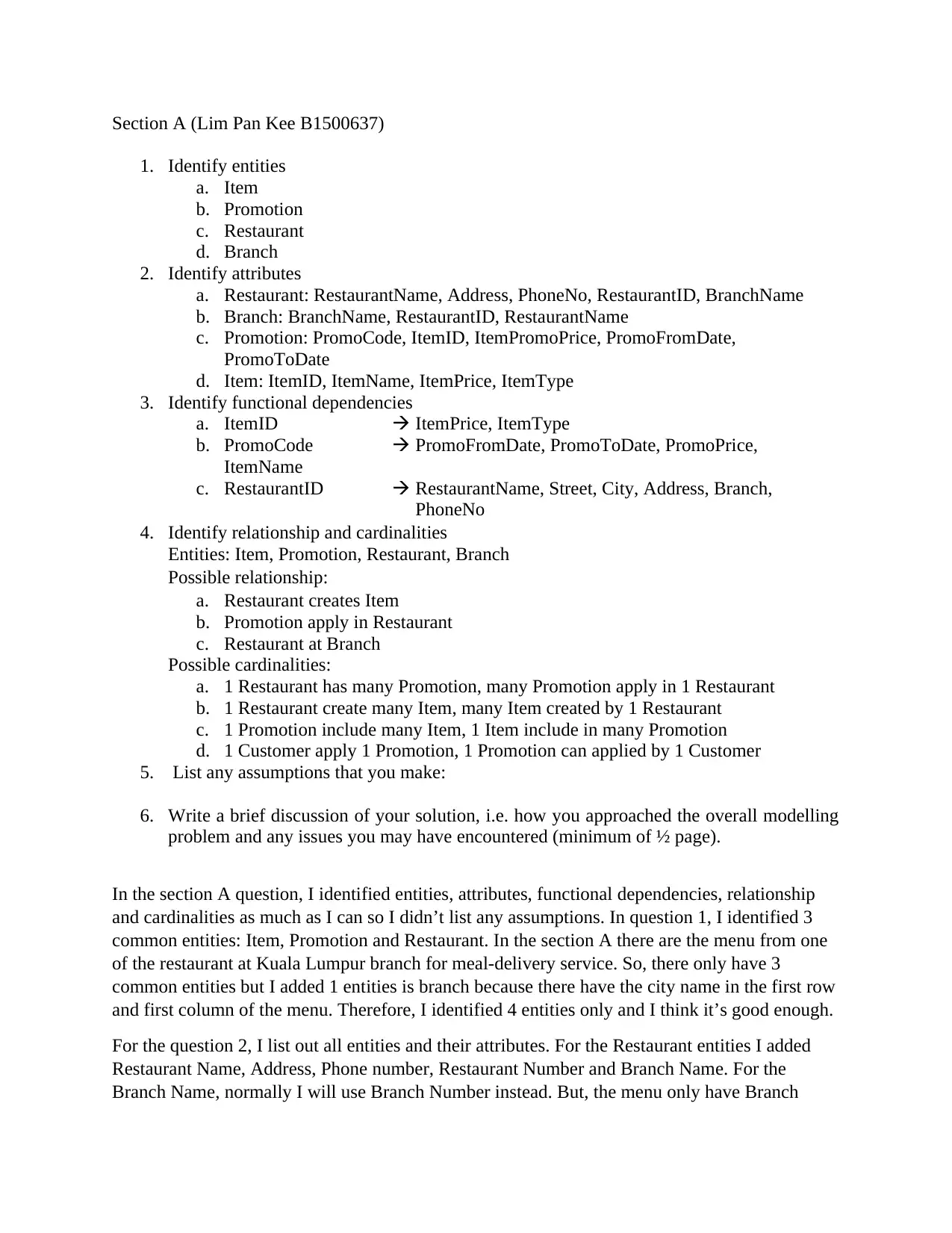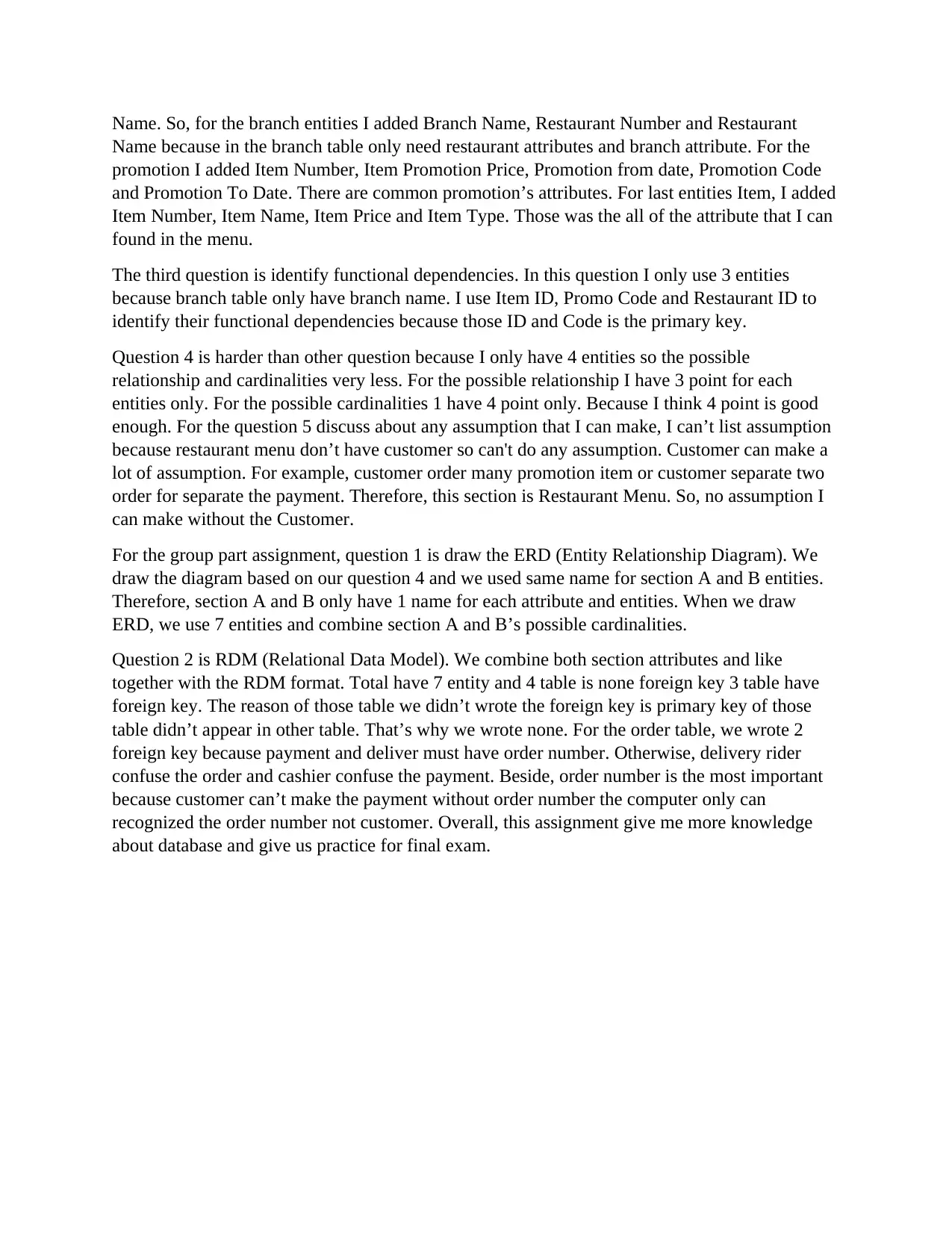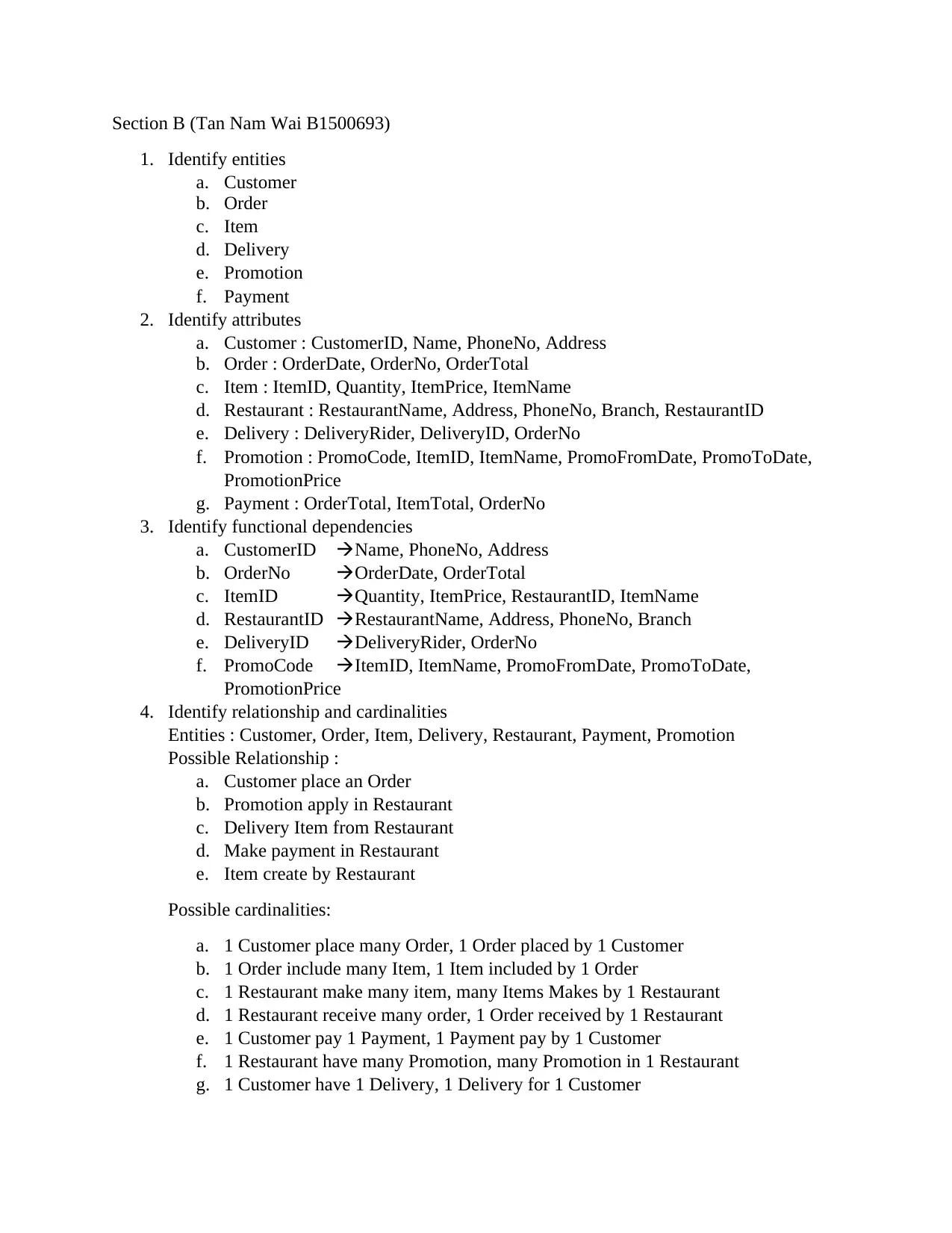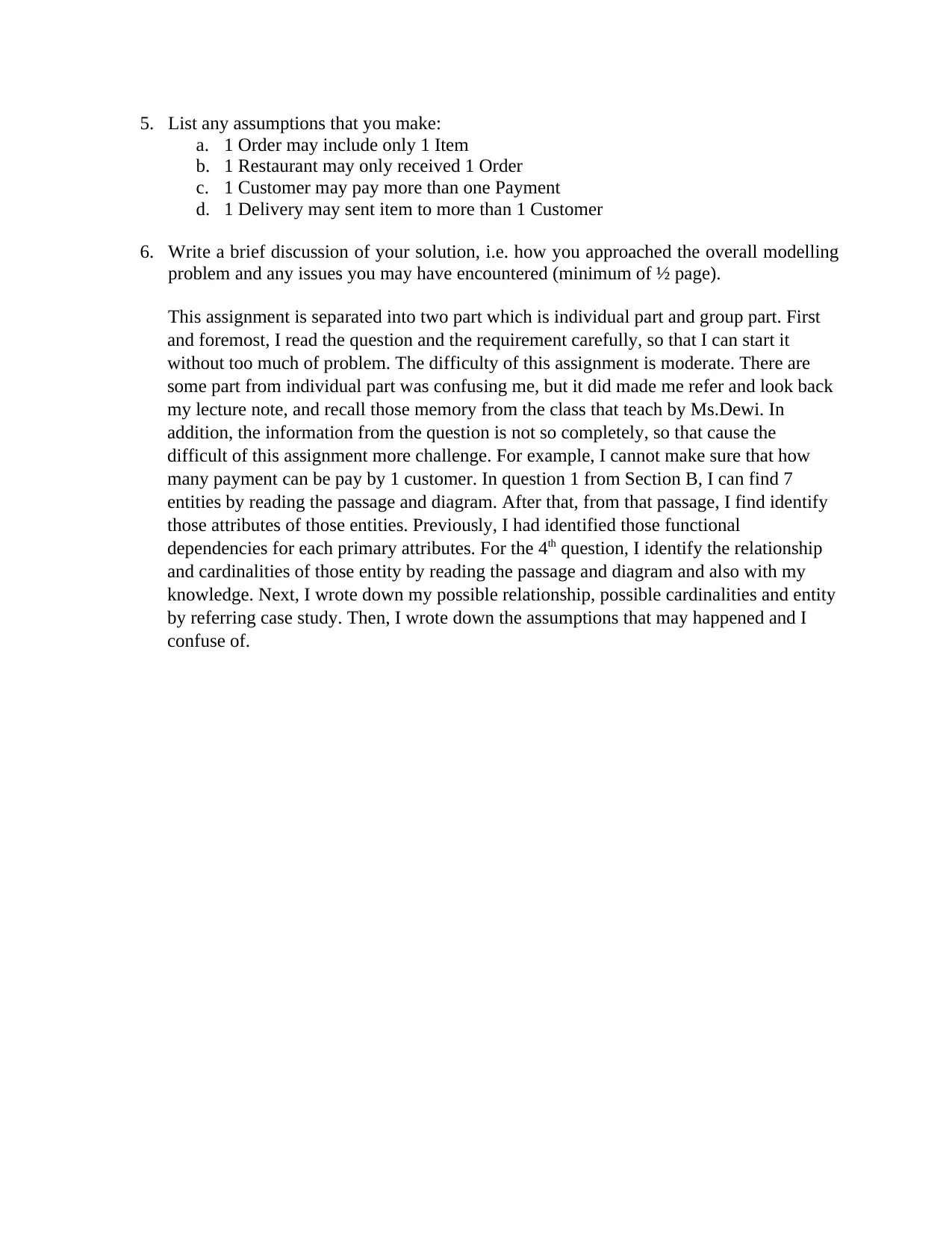Entities that didn't appear in other tables
VerifiedAdded on 2019/09/18
|6
|1620
|435
Essay
AI Summary
For the order table, we wrote 2 foreign keys because payment and delivery must have an order number. Otherwise, delivery riders might confuse orders and cashiers might confuse payments. Moreover, the order number is the most important as customers cannot make a payment without an order number; the computer can only recognize the order number, not the customer. Overall, this assignment gave me more knowledge about databases and practice for our final exam.
Contribute Materials
Your contribution can guide someone’s learning journey. Share your
documents today.

Section A (Lim Pan Kee B1500637)
1. Identify entities
a. Item
b. Promotion
c. Restaurant
d. Branch
2. Identify attributes
a. Restaurant: RestaurantName, Address, PhoneNo, RestaurantID, BranchName
b. Branch: BranchName, RestaurantID, RestaurantName
c. Promotion: PromoCode, ItemID, ItemPromoPrice, PromoFromDate,
PromoToDate
d. Item: ItemID, ItemName, ItemPrice, ItemType
3. Identify functional dependencies
a. ItemID ItemPrice, ItemType
b. PromoCode PromoFromDate, PromoToDate, PromoPrice,
ItemName
c. RestaurantID RestaurantName, Street, City, Address, Branch,
PhoneNo
4. Identify relationship and cardinalities
Entities: Item, Promotion, Restaurant, Branch
Possible relationship:
a. Restaurant creates Item
b. Promotion apply in Restaurant
c. Restaurant at Branch
Possible cardinalities:
a. 1 Restaurant has many Promotion, many Promotion apply in 1 Restaurant
b. 1 Restaurant create many Item, many Item created by 1 Restaurant
c. 1 Promotion include many Item, 1 Item include in many Promotion
d. 1 Customer apply 1 Promotion, 1 Promotion can applied by 1 Customer
5. List any assumptions that you make:
6. Write a brief discussion of your solution, i.e. how you approached the overall modelling
problem and any issues you may have encountered (minimum of ½ page).
In the section A question, I identified entities, attributes, functional dependencies, relationship
and cardinalities as much as I can so I didn’t list any assumptions. In question 1, I identified 3
common entities: Item, Promotion and Restaurant. In the section A there are the menu from one
of the restaurant at Kuala Lumpur branch for meal-delivery service. So, there only have 3
common entities but I added 1 entities is branch because there have the city name in the first row
and first column of the menu. Therefore, I identified 4 entities only and I think it’s good enough.
For the question 2, I list out all entities and their attributes. For the Restaurant entities I added
Restaurant Name, Address, Phone number, Restaurant Number and Branch Name. For the
Branch Name, normally I will use Branch Number instead. But, the menu only have Branch
1. Identify entities
a. Item
b. Promotion
c. Restaurant
d. Branch
2. Identify attributes
a. Restaurant: RestaurantName, Address, PhoneNo, RestaurantID, BranchName
b. Branch: BranchName, RestaurantID, RestaurantName
c. Promotion: PromoCode, ItemID, ItemPromoPrice, PromoFromDate,
PromoToDate
d. Item: ItemID, ItemName, ItemPrice, ItemType
3. Identify functional dependencies
a. ItemID ItemPrice, ItemType
b. PromoCode PromoFromDate, PromoToDate, PromoPrice,
ItemName
c. RestaurantID RestaurantName, Street, City, Address, Branch,
PhoneNo
4. Identify relationship and cardinalities
Entities: Item, Promotion, Restaurant, Branch
Possible relationship:
a. Restaurant creates Item
b. Promotion apply in Restaurant
c. Restaurant at Branch
Possible cardinalities:
a. 1 Restaurant has many Promotion, many Promotion apply in 1 Restaurant
b. 1 Restaurant create many Item, many Item created by 1 Restaurant
c. 1 Promotion include many Item, 1 Item include in many Promotion
d. 1 Customer apply 1 Promotion, 1 Promotion can applied by 1 Customer
5. List any assumptions that you make:
6. Write a brief discussion of your solution, i.e. how you approached the overall modelling
problem and any issues you may have encountered (minimum of ½ page).
In the section A question, I identified entities, attributes, functional dependencies, relationship
and cardinalities as much as I can so I didn’t list any assumptions. In question 1, I identified 3
common entities: Item, Promotion and Restaurant. In the section A there are the menu from one
of the restaurant at Kuala Lumpur branch for meal-delivery service. So, there only have 3
common entities but I added 1 entities is branch because there have the city name in the first row
and first column of the menu. Therefore, I identified 4 entities only and I think it’s good enough.
For the question 2, I list out all entities and their attributes. For the Restaurant entities I added
Restaurant Name, Address, Phone number, Restaurant Number and Branch Name. For the
Branch Name, normally I will use Branch Number instead. But, the menu only have Branch
Secure Best Marks with AI Grader
Need help grading? Try our AI Grader for instant feedback on your assignments.

Name. So, for the branch entities I added Branch Name, Restaurant Number and Restaurant
Name because in the branch table only need restaurant attributes and branch attribute. For the
promotion I added Item Number, Item Promotion Price, Promotion from date, Promotion Code
and Promotion To Date. There are common promotion’s attributes. For last entities Item, I added
Item Number, Item Name, Item Price and Item Type. Those was the all of the attribute that I can
found in the menu.
The third question is identify functional dependencies. In this question I only use 3 entities
because branch table only have branch name. I use Item ID, Promo Code and Restaurant ID to
identify their functional dependencies because those ID and Code is the primary key.
Question 4 is harder than other question because I only have 4 entities so the possible
relationship and cardinalities very less. For the possible relationship I have 3 point for each
entities only. For the possible cardinalities 1 have 4 point only. Because I think 4 point is good
enough. For the question 5 discuss about any assumption that I can make, I can’t list assumption
because restaurant menu don’t have customer so can't do any assumption. Customer can make a
lot of assumption. For example, customer order many promotion item or customer separate two
order for separate the payment. Therefore, this section is Restaurant Menu. So, no assumption I
can make without the Customer.
For the group part assignment, question 1 is draw the ERD (Entity Relationship Diagram). We
draw the diagram based on our question 4 and we used same name for section A and B entities.
Therefore, section A and B only have 1 name for each attribute and entities. When we draw
ERD, we use 7 entities and combine section A and B’s possible cardinalities.
Question 2 is RDM (Relational Data Model). We combine both section attributes and like
together with the RDM format. Total have 7 entity and 4 table is none foreign key 3 table have
foreign key. The reason of those table we didn’t wrote the foreign key is primary key of those
table didn’t appear in other table. That’s why we wrote none. For the order table, we wrote 2
foreign key because payment and deliver must have order number. Otherwise, delivery rider
confuse the order and cashier confuse the payment. Beside, order number is the most important
because customer can’t make the payment without order number the computer only can
recognized the order number not customer. Overall, this assignment give me more knowledge
about database and give us practice for final exam.
Name because in the branch table only need restaurant attributes and branch attribute. For the
promotion I added Item Number, Item Promotion Price, Promotion from date, Promotion Code
and Promotion To Date. There are common promotion’s attributes. For last entities Item, I added
Item Number, Item Name, Item Price and Item Type. Those was the all of the attribute that I can
found in the menu.
The third question is identify functional dependencies. In this question I only use 3 entities
because branch table only have branch name. I use Item ID, Promo Code and Restaurant ID to
identify their functional dependencies because those ID and Code is the primary key.
Question 4 is harder than other question because I only have 4 entities so the possible
relationship and cardinalities very less. For the possible relationship I have 3 point for each
entities only. For the possible cardinalities 1 have 4 point only. Because I think 4 point is good
enough. For the question 5 discuss about any assumption that I can make, I can’t list assumption
because restaurant menu don’t have customer so can't do any assumption. Customer can make a
lot of assumption. For example, customer order many promotion item or customer separate two
order for separate the payment. Therefore, this section is Restaurant Menu. So, no assumption I
can make without the Customer.
For the group part assignment, question 1 is draw the ERD (Entity Relationship Diagram). We
draw the diagram based on our question 4 and we used same name for section A and B entities.
Therefore, section A and B only have 1 name for each attribute and entities. When we draw
ERD, we use 7 entities and combine section A and B’s possible cardinalities.
Question 2 is RDM (Relational Data Model). We combine both section attributes and like
together with the RDM format. Total have 7 entity and 4 table is none foreign key 3 table have
foreign key. The reason of those table we didn’t wrote the foreign key is primary key of those
table didn’t appear in other table. That’s why we wrote none. For the order table, we wrote 2
foreign key because payment and deliver must have order number. Otherwise, delivery rider
confuse the order and cashier confuse the payment. Beside, order number is the most important
because customer can’t make the payment without order number the computer only can
recognized the order number not customer. Overall, this assignment give me more knowledge
about database and give us practice for final exam.

Section B (Tan Nam Wai B1500693)
1. Identify entities
a. Customer
b. Order
c. Item
d. Delivery
e. Promotion
f. Payment
2. Identify attributes
a. Customer : CustomerID, Name, PhoneNo, Address
b. Order : OrderDate, OrderNo, OrderTotal
c. Item : ItemID, Quantity, ItemPrice, ItemName
d. Restaurant : RestaurantName, Address, PhoneNo, Branch, RestaurantID
e. Delivery : DeliveryRider, DeliveryID, OrderNo
f. Promotion : PromoCode, ItemID, ItemName, PromoFromDate, PromoToDate,
PromotionPrice
g. Payment : OrderTotal, ItemTotal, OrderNo
3. Identify functional dependencies
a. CustomerID Name, PhoneNo, Address
b. OrderNo OrderDate, OrderTotal
c. ItemID Quantity, ItemPrice, RestaurantID, ItemName
d. RestaurantID RestaurantName, Address, PhoneNo, Branch
e. DeliveryID DeliveryRider, OrderNo
f. PromoCode ItemID, ItemName, PromoFromDate, PromoToDate,
PromotionPrice
4. Identify relationship and cardinalities
Entities : Customer, Order, Item, Delivery, Restaurant, Payment, Promotion
Possible Relationship :
a. Customer place an Order
b. Promotion apply in Restaurant
c. Delivery Item from Restaurant
d. Make payment in Restaurant
e. Item create by Restaurant
Possible cardinalities:
a. 1 Customer place many Order, 1 Order placed by 1 Customer
b. 1 Order include many Item, 1 Item included by 1 Order
c. 1 Restaurant make many item, many Items Makes by 1 Restaurant
d. 1 Restaurant receive many order, 1 Order received by 1 Restaurant
e. 1 Customer pay 1 Payment, 1 Payment pay by 1 Customer
f. 1 Restaurant have many Promotion, many Promotion in 1 Restaurant
g. 1 Customer have 1 Delivery, 1 Delivery for 1 Customer
1. Identify entities
a. Customer
b. Order
c. Item
d. Delivery
e. Promotion
f. Payment
2. Identify attributes
a. Customer : CustomerID, Name, PhoneNo, Address
b. Order : OrderDate, OrderNo, OrderTotal
c. Item : ItemID, Quantity, ItemPrice, ItemName
d. Restaurant : RestaurantName, Address, PhoneNo, Branch, RestaurantID
e. Delivery : DeliveryRider, DeliveryID, OrderNo
f. Promotion : PromoCode, ItemID, ItemName, PromoFromDate, PromoToDate,
PromotionPrice
g. Payment : OrderTotal, ItemTotal, OrderNo
3. Identify functional dependencies
a. CustomerID Name, PhoneNo, Address
b. OrderNo OrderDate, OrderTotal
c. ItemID Quantity, ItemPrice, RestaurantID, ItemName
d. RestaurantID RestaurantName, Address, PhoneNo, Branch
e. DeliveryID DeliveryRider, OrderNo
f. PromoCode ItemID, ItemName, PromoFromDate, PromoToDate,
PromotionPrice
4. Identify relationship and cardinalities
Entities : Customer, Order, Item, Delivery, Restaurant, Payment, Promotion
Possible Relationship :
a. Customer place an Order
b. Promotion apply in Restaurant
c. Delivery Item from Restaurant
d. Make payment in Restaurant
e. Item create by Restaurant
Possible cardinalities:
a. 1 Customer place many Order, 1 Order placed by 1 Customer
b. 1 Order include many Item, 1 Item included by 1 Order
c. 1 Restaurant make many item, many Items Makes by 1 Restaurant
d. 1 Restaurant receive many order, 1 Order received by 1 Restaurant
e. 1 Customer pay 1 Payment, 1 Payment pay by 1 Customer
f. 1 Restaurant have many Promotion, many Promotion in 1 Restaurant
g. 1 Customer have 1 Delivery, 1 Delivery for 1 Customer

5. List any assumptions that you make:
a. 1 Order may include only 1 Item
b. 1 Restaurant may only received 1 Order
c. 1 Customer may pay more than one Payment
d. 1 Delivery may sent item to more than 1 Customer
6. Write a brief discussion of your solution, i.e. how you approached the overall modelling
problem and any issues you may have encountered (minimum of ½ page).
This assignment is separated into two part which is individual part and group part. First
and foremost, I read the question and the requirement carefully, so that I can start it
without too much of problem. The difficulty of this assignment is moderate. There are
some part from individual part was confusing me, but it did made me refer and look back
my lecture note, and recall those memory from the class that teach by Ms.Dewi. In
addition, the information from the question is not so completely, so that cause the
difficult of this assignment more challenge. For example, I cannot make sure that how
many payment can be pay by 1 customer. In question 1 from Section B, I can find 7
entities by reading the passage and diagram. After that, from that passage, I find identify
those attributes of those entities. Previously, I had identified those functional
dependencies for each primary attributes. For the 4th question, I identify the relationship
and cardinalities of those entity by reading the passage and diagram and also with my
knowledge. Next, I wrote down my possible relationship, possible cardinalities and entity
by referring case study. Then, I wrote down the assumptions that may happened and I
confuse of.
a. 1 Order may include only 1 Item
b. 1 Restaurant may only received 1 Order
c. 1 Customer may pay more than one Payment
d. 1 Delivery may sent item to more than 1 Customer
6. Write a brief discussion of your solution, i.e. how you approached the overall modelling
problem and any issues you may have encountered (minimum of ½ page).
This assignment is separated into two part which is individual part and group part. First
and foremost, I read the question and the requirement carefully, so that I can start it
without too much of problem. The difficulty of this assignment is moderate. There are
some part from individual part was confusing me, but it did made me refer and look back
my lecture note, and recall those memory from the class that teach by Ms.Dewi. In
addition, the information from the question is not so completely, so that cause the
difficult of this assignment more challenge. For example, I cannot make sure that how
many payment can be pay by 1 customer. In question 1 from Section B, I can find 7
entities by reading the passage and diagram. After that, from that passage, I find identify
those attributes of those entities. Previously, I had identified those functional
dependencies for each primary attributes. For the 4th question, I identify the relationship
and cardinalities of those entity by reading the passage and diagram and also with my
knowledge. Next, I wrote down my possible relationship, possible cardinalities and entity
by referring case study. Then, I wrote down the assumptions that may happened and I
confuse of.
Paraphrase This Document
Need a fresh take? Get an instant paraphrase of this document with our AI Paraphraser

Group Part:
1. ERD
2. RDM
a. Customer( CustomerID, CustomerName, Phone, Address)
Primary key: CustomerID
Foreign key: none
b. Order( OrderNo, OrderDate, OrderTotal)
Primary key: OrderNo
Foreign key: OrderNo References Payment(OrderNo)
OrderNo References Delivery(OrderNo)
c. Item( ItemID, Quantity, ItemPrice, ItemType, ItemName)
Primary key: ItemID
Foreign key: ItemID References Promotion(ItemID)
d. Restaurant( RestaurantID, RestaurantName, Address, PhoneNo, Branch)
Primary key: RestaurantID
1. ERD
2. RDM
a. Customer( CustomerID, CustomerName, Phone, Address)
Primary key: CustomerID
Foreign key: none
b. Order( OrderNo, OrderDate, OrderTotal)
Primary key: OrderNo
Foreign key: OrderNo References Payment(OrderNo)
OrderNo References Delivery(OrderNo)
c. Item( ItemID, Quantity, ItemPrice, ItemType, ItemName)
Primary key: ItemID
Foreign key: ItemID References Promotion(ItemID)
d. Restaurant( RestaurantID, RestaurantName, Address, PhoneNo, Branch)
Primary key: RestaurantID

Foreign key: RestaurantID References Branch(RestaurantID)
e. Promotion( PromoCode, ItemID, ItemName, PromoFromDate, PromoToDate,
PromotionPrice)
Primary key: PromoCode
Foreign key: none
f. Delivery( DeliveryID, DeliveryRider, OrderNo)
Primary key: DeliveryNo
Foreign key: none
g. Branch( BranchName, RestaurantID, RestaurantName)
Primary key: BranchName
Foreign key: none
h. Payment( OrderTotal, ItemTotal, OrderNo)
Primary key: OrderTotal
Foreign key: OrderTotal References Order(OrderTotal)
e. Promotion( PromoCode, ItemID, ItemName, PromoFromDate, PromoToDate,
PromotionPrice)
Primary key: PromoCode
Foreign key: none
f. Delivery( DeliveryID, DeliveryRider, OrderNo)
Primary key: DeliveryNo
Foreign key: none
g. Branch( BranchName, RestaurantID, RestaurantName)
Primary key: BranchName
Foreign key: none
h. Payment( OrderTotal, ItemTotal, OrderNo)
Primary key: OrderTotal
Foreign key: OrderTotal References Order(OrderTotal)
1 out of 6
Your All-in-One AI-Powered Toolkit for Academic Success.
+13062052269
info@desklib.com
Available 24*7 on WhatsApp / Email
![[object Object]](/_next/static/media/star-bottom.7253800d.svg)
Unlock your academic potential
© 2024 | Zucol Services PVT LTD | All rights reserved.
